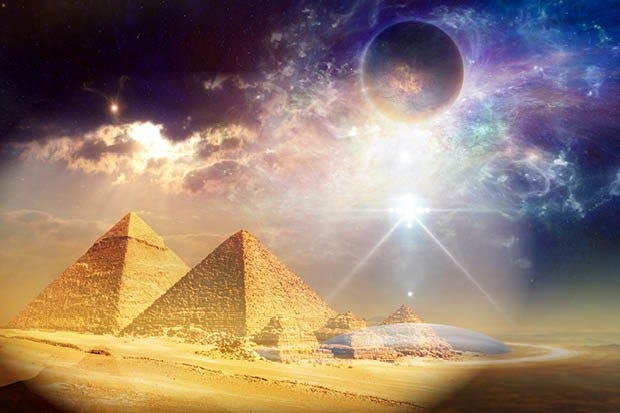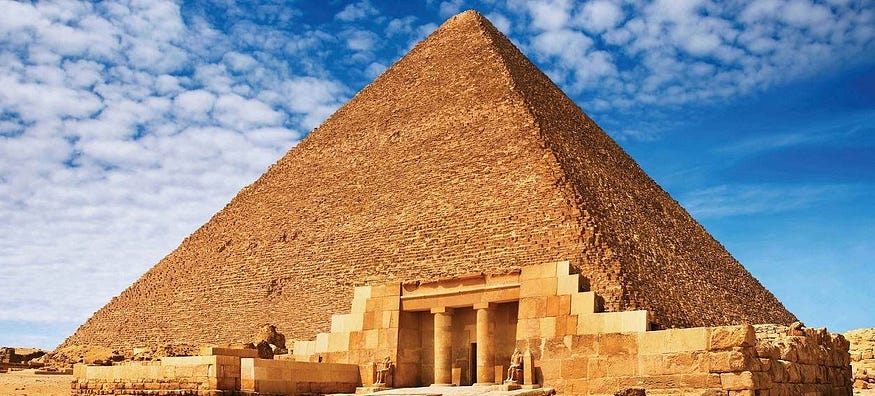
Planetary Energy inThe ancient Egyptian civilization is known as one of the most mysterious and inspiring cultures in human history. The Egyptians were not only advanced in architecture, mathematics, and astronomy, but also had a deep understanding of humanity’s connection to the cosmos
Also read: Warsaw: The Ultimate Analytical Guide to Europe’s Phoenix City
. The pyramids and temples of Egypt are more than just stone structures; they were essentially “cosmic energy machines” intricately connected to the planets and stars. The Pyramids of Giza, along with magnificent temples such as Karnak and Abu Simbel, are not only architectural wonders, but are also, according to many scholars, deeply tied to the astronomical knowledge and cosmic beliefs of the ancient Egyptians. This article explores the connection between the pyramids and temples of ancient Egypt, planetary energy, and the Egyptian cosmic worldview.

Planetary Energy on Egypt’s Pyramidsin Temples
Each temple in ancient Egypt was built not only to worship a specific god, but also to align with the vibrations and frequencies of specific planets. The orientation of the temple entrances and the angles of their columns were designed so that at certain times of the year, the energy of the sun or a specific planet would enter the structure directly. For example, the Temple of Karnak in Luxor, one of the largest religious complexes in ancient Egypt, was built with amazing precision to align with astronomical events. Its main axis points towards the rising sun during the summer solstice, and certain parts of it correspond to specific stars or planets, indicating the Egyptians’ deep understanding of celestial movements.
also read: Haarlem’s Unbeatable Charm: A Definitive Guide to The Netherlands’ Quintessential City
Some metaphysical theorists believe that the Egyptian pyramids acted as giant cosmic antennas. They argue that the pyramid shape attracts cosmic energy (often known as prana) and concentrates it at the core of the structure. According to Egyptian beliefs, this energy can facilitate spiritual processes such as soul travel, communication with the gods, or even the preservation of the body after death. Modern experiments have shown that the shape of a pyramid can affect the energy of the environment — there are many stories about razors staying sharp inside pyramids or changes in the crystalline structure of water. These findings suggest that the architecture of the pyramids may reflect an advanced understanding of the invisible energies of the universe.
Planetary Energy: Ancient Egyptians linked gods to celestial bodies, each with unique energies
The sun :was a symbol of Ra, the embodiment of the life force and light.
The moon was associated with Thoth, the god of wisdom and time.
Venus: was associated with the goddess of love and beauty, and represented balance and gravity.
Mars :represented power, war, and determination.
Jupiter :symbolized justice and sovereignty, while Saturn represented law, limitation, and the cycles of fate.

The Pyramids of Giza and Their Connection to the Planets
The Pyramids of Giza, especially the Great Pyramid of Khufu, remain one of the Seven Wonders of the Ancient World and hold countless mysteries. One compelling theory is their connection to the constellation of Orion and the planets of our solar system. Renowned scholar Robert Bauval proposed the Orion correlation theory, stating that the three main pyramids of Giza (Khufu, Khafre, and Menkaure) are positioned to mirror the three stars of Orion’s belt. This theory suggests that the ancient Egyptians designed the pyramids as a symbolic bridge between the earth and the sky.
In addition, some researchers believe that the interior design of the Great Pyramid, especially its passageways and chambers, may be associated with specific planets. For example, the narrow shafts extending outward from the pyramid, often called “ventilation shafts,” were probably designed to direct the pharaoh’s soul toward specific stars or planets. These shafts are precisely aligned with celestial bodies such as Sirius and the stars of Orion’s belt. Some hypothesize that these shafts acted as channels to draw cosmic energy into the pyramid, enhancing its spiritual function.
Planetary Energy and Egyptian Temples
Ancient Egyptian temples, such as those at Edfu and Dendera, appear to have been built with planetary influences in mind. The Dendera Temple, dedicated to Hathor (the goddess of love and the sky), has intricate astronomical reliefs carved into its ceiling, known as the “Dendera Zodiac.” These carvings reveal the Egyptians’ sophisticated understanding of planetary movements and their connection to temporal and spiritual cycles.
The Egyptians believed that planets and stars possessed unique energies that could influence human life and even the fate of pharaohs. Temples were therefore designed to harness these energies for use in religious ceremonies and spiritual rituals. A notable example is the temple of Abu Simbel, where twice a year (around February 22 and October 22), the rays of the rising sun penetrate precisely into the inner sanctuary, illuminating the statues of the gods. This phenomenon highlights the temple’s precise alignment with celestial movements, including the position of the sun and possibly other planets.

The Role of Cosmic Beliefs in Architecture
Ancient Egyptian architecture was not simply a feat of engineering, but rather a reflection of the Egyptians’ cosmic worldview. They believed that the world was governed by a divine order maintained by the gods through the movements of the planets and stars. Pyramids and temples served as a bridge between the earthly and celestial realms. These structures were designed not only to be physically stable, but also to be spiritually aligned with cosmic energies.
For example, the precise orientation of the pyramids to the cardinal directions (north, south, east, and west) suggests an attempt to achieve balance and harmony with natural and cosmic forces. The use of specific materials, such as white limestone and red granite, may have been chosen for their perceived energetic properties. Some theorists believe that these stones could amplify and channel cosmic energies, including planetary energies, into the structures.
Modern Theories About Pyramid Energy
In modern times, some researchers and metaphysical enthusiasts have suggested that the Egyptian pyramids served as “energy powerhouses.” Although these theories are often met with scientific skepticism, they suggest that the geometric shape and materials of the pyramids could concentrate electromagnetic or cosmic energies. Some even speculate that the pyramids served as a means of communication with planets or extraterrestrial beings, although such claims often fall into the realm of pseudoscience.
However, it is undeniable that the ancient Egyptians had a deep understanding of geometry and its environmental effects. The shape of the pyramid, with its ability to concentrate energy at its apex, may have been designed — symbolically or practically — to enhance communication with the heavens.
Conclusion
The temples and pyramids of ancient Egypt were more than just stone structures or architectural achievements; they were essentially “living libraries of energy.” Astronomy, mythology, and metaphysics are intertwined in these structures and are expressed in sacred architecture.
The connection between these monuments and planetary energy reflects the Egyptians’ belief in a cosmic order that connects humanity, the earth, and the heavens. This is why the pyramids and temples of Egypt continue to fascinate researchers and metaphysical enthusiasts, and continue to be an endless source of inspiration and mystery.The Power of Planetary Energy in Ancient Egypt







